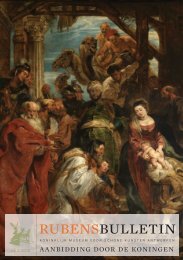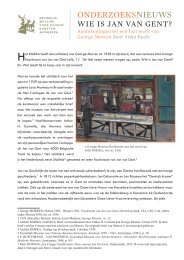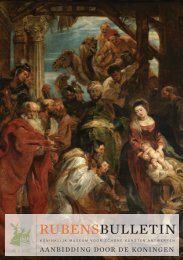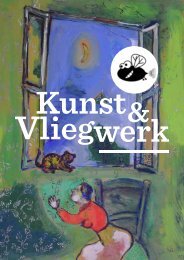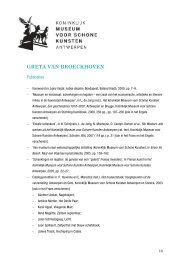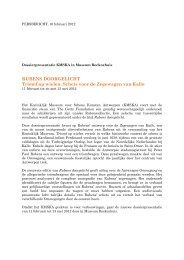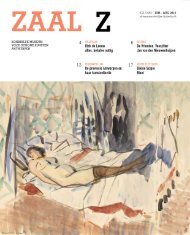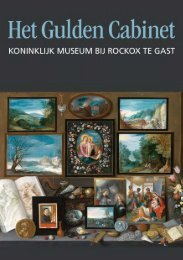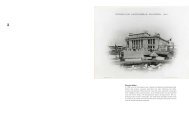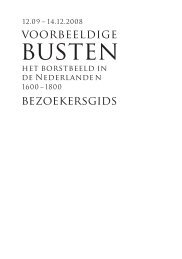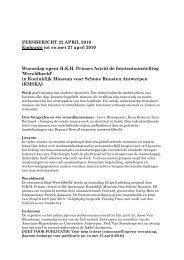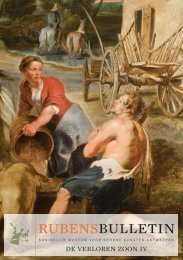Triumph In Antwerp Rubens's oil Sketch - Koninklijk Museum voor ...
Triumph In Antwerp Rubens's oil Sketch - Koninklijk Museum voor ...
Triumph In Antwerp Rubens's oil Sketch - Koninklijk Museum voor ...
You also want an ePaper? Increase the reach of your titles
YUMPU automatically turns print PDFs into web optimized ePapers that Google loves.
BULLETIN<br />
BULLETIN<br />
Scenography of a festive event<br />
The descriptions of the ceremonial entries organized for the new governors<br />
and the lists of the Ommegang poyncten discussed above can be found<br />
in the literature on Joyous Entries and Ommegangen. 35 An interesting<br />
manuscript I found during my research in the <strong>Antwerp</strong> city archives may<br />
be added to the literature. The document has not been referred to before,<br />
and the new information it contains contributes to a better understanding<br />
of the <strong>Antwerp</strong> festive tradition. It is named ‘Ordre van den Ommeganck’<br />
and appears to be a seventeenth-century protocol of an Ommegang event. 36<br />
The manuscript is not dated, but given its similarity to other seventeenthcentury<br />
written texts, it could be located in <strong>Antwerp</strong> in the seventeenth<br />
century – most probably the second part of the century, although it might<br />
also be a copy of an older document. 37 It is possible that the instructions<br />
for organizing the Ommegang were used as a guide on the occasion of (an)<br />
earlier event(s). If the manuscript is a copy, the original must date from after<br />
the Ommegang of 1599, when the Sea Chariot or the Chariot of Neptune<br />
referred to in the document made their appearance in the Joyous Entry of<br />
the Archdukes Albert and Isabella. (The Elephant, also mentioned in the<br />
text, first figured in the triumphal entry of François d’Alençon in 1582.)<br />
The ‘Ordre van den Ommeganck’ gives a vibrant impression of<br />
an <strong>Antwerp</strong> parade as described above. Obviously the festive ceremonies<br />
were very well organized. The document offers a kind of scenography,<br />
prescribing the progress of the procession and arranging the sequence<br />
35<br />
Literature about the Joyous Entries, the Ommegangen and the urban culture of the Southern<br />
Netherlands in the seventeenth century includes: Van Bruane 2008; Thøfner 2007; Joukes 1990;<br />
Martin 1972; Van de Velde and Vlieghe 1969; Prims 1949; Von Roeder-Baumbach 1943;<br />
De Burbure 1878.<br />
36<br />
Stadsarchief <strong>Antwerp</strong>en, the <strong>Antwerp</strong> City Archive; Search: Ancien Régime van de Stad<br />
<strong>Antwerp</strong>en; Stadsbestuur: archief <strong>voor</strong>tvloeiend uit de uitgeoefende functies; Bestuur en beleid<br />
(Privilegekamer); Dossiers van de secretarie geordend naar onderwerp; Plechtigheden; Ommegangen<br />
en Processies: file PK 1644. The ‘Ordre van den Ommeganck’ is one of the documents in the file<br />
‘Ommegangen en Processies’, containing sixteenth- to eighteenth-century documents concerning<br />
processions in the city of <strong>Antwerp</strong>.<br />
37<br />
I want to thank Dr Marie Juliette Marinus, advisor for scientific work of the <strong>Antwerp</strong> Stadsarchief,<br />
for sharing her thoughts on the subject.<br />
and the distance of musicians and cars, their place and movements in the<br />
streets and on Grote Markt. Musicians playing the cymbals and trumpets<br />
precede the parade of the Big Ship, the Small Ships, the Whale, the Little<br />
Dolphins and the Sea Chariot, all subjects referring to the river and the sea.<br />
Musicians playing the horn precede the Maidens’ Chariot, St Michael’s<br />
Chariot and Mount Parnassus; they are followed by the Giant, the Camel,<br />
the Lion, the Small Giants and the Elephant (all but St Michael’s Chariot<br />
representing secular themes). The majority of the subjects listed in the<br />
document participated in the <strong>Antwerp</strong> Ommegang from the earliest days<br />
and were still part of it in more recent times. 38<br />
According to the ‘Ordre van den Ommeganck’, the event took place<br />
on Grote Markt, in front of the city hall. A portion of the parade was waiting<br />
in Hoogstraat, while the Maidens’ Chariot was advancing in front of the<br />
prince. The musicians and cars were positioned on the square following<br />
the instructions of the ‘directors’ or aenleijders. Some of the cars were<br />
turning in circles round the market square, while others were positioned<br />
in what seems to have been a complex pattern. An interesting note written<br />
in the margin was meant as a reminder to put a supply of water in tubs on<br />
the steps of the city hall in advance, in order to provision Mount Parnassus<br />
and the Whale. The last page stipulated that the cars, before leaving the<br />
scene, had to turn round twice in front of the prince.<br />
Considering the seventeenth-century ‘Ordre van den Ommeganck’,<br />
it may be concluded that in 1638 the <strong>Antwerp</strong> city government commissioned<br />
a triumphal chariot to ride in a festive procession similar to the<br />
one described in the manuscript. At this time, the <strong>Antwerp</strong> Ommegang, a<br />
popular ceremony organized for and by the city and its inhabitants, was<br />
attended by the prince in person and specifically adapted to his presence.<br />
Since the manuscript is not dated, we cannot be sure to which of the<br />
seventeenth-century governors it refers, but it might be Cardinal-<strong>In</strong>fante<br />
Ferdinand if the handwriting could be dated to between 1635 and 1641. <strong>In</strong><br />
that case, the ceremony may have been part of the festivities accompanying<br />
38<br />
The <strong>Antwerp</strong> <strong>Museum</strong> aan de Stroom (MAS) owns a collection of traditional Ommegang bozetti<br />
and design drawings, dating from the first half of the twentieth century. The city warehouse<br />
preserves (remakes of ) Ommegang cars, which were used in Wilrijk near <strong>Antwerp</strong> in 2005 and 2010.<br />
56<br />
57




